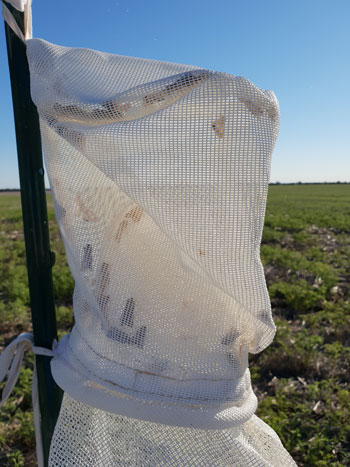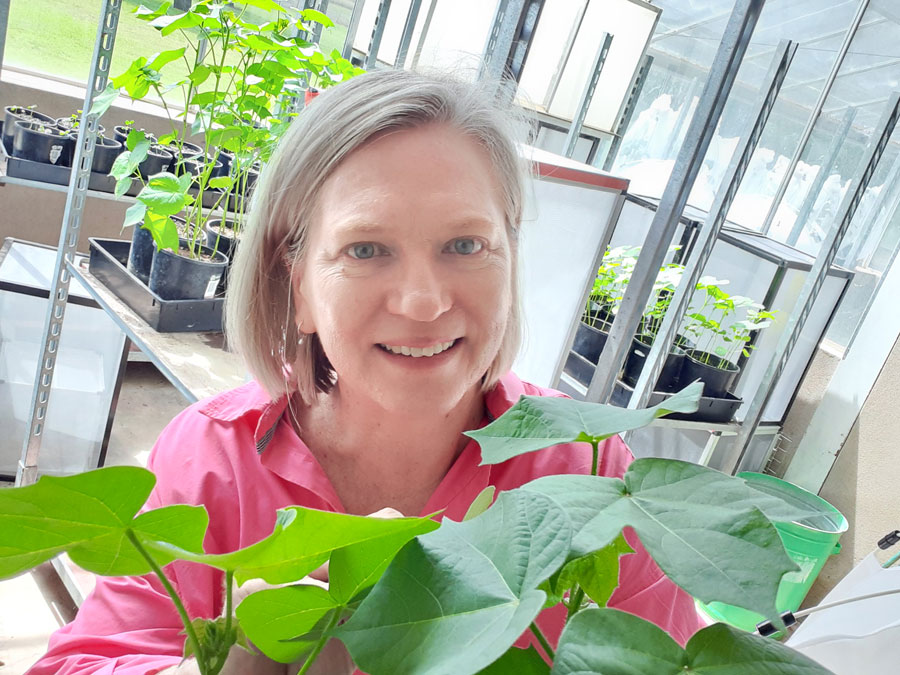Key points
- Queensland’s central and northern areas are considered high risk for fall armyworm and Helicoverpa armigera pests
- Trapping adult moths in these regions and using sensitive quantitative genetic tools to test for insecticide resistance gives an indication of evolving resistance
- NSW Department of Primary Industries specialist Dr Lisa Bird says that both species have a strong capacity to develop resistance to insecticides. It makes early warning critical for the sustainable management of these damaging pests
In central and northern Queensland, pest surveillance is helping the grains, horticulture and cotton industries gain early warning on insecticide resistance in fall armyworm (FAW) and Helicoverpa armigera pest populations.
Speaking at the Cesar Australia-hosted Crop Protection Forum late last year, New South Wales Department of Primary Industries (DPI) researcher Dr Lisa Bird explained the resistance surveillance program.
“These areas of Queensland are considered high-risk areas. This is where both insect pressure and insecticide use are pretty high,” Dr Bird says.
From these established bases, adult FAW moths can easily move into other cropping areas. “FAW adults, in particular, are strong flyers and can move very long distances on prevailing winds. That strong flight capacity means the populations that build up in these areas can easily disperse and establish in any region where host crops are available.”
To emphasise the point, she says FAW moths number in the thousands in Queensland, compared with the hundreds in NSW.
 Traps are helping the grains, horticulture and cotton industries gain an early warning on insecticide resistance in fall armyworm and Helicoverpa armigera pest populations. Photo: Linda Drynan, NSW DPI
Traps are helping the grains, horticulture and cotton industries gain an early warning on insecticide resistance in fall armyworm and Helicoverpa armigera pest populations. Photo: Linda Drynan, NSW DPI
This focus on monitoring in northern cropping regions is also important for managing resistance in H. armigera populations. “Although they don’t have the same migratory capacity as FAW, H. armigera can still get pushed around on weather fronts and so can disperse between regions.”
With selective insecticide use a key part of integrated pest management plans, monitoring for new resistance among these pests is important.
H. armigera has already developed resistance to a wide range of insecticides and resistance was also expected to be present in FAW populations when it arrived in Australia back in 2020, she says.
“FAW had already been exposed to selection pressure from broad-spectrum insecticides on a global scale decades before it arrived, so unsurprisingly this was always going to impact how effective some products were going to be on Australia FAW populations.”
The surveillance system helps researchers understand whether insecticide resistance is developing. This is done by detecting evolving genes in the grandchildren of field-collected insects. “This is an extremely sensitive technique that can tell us whether resistance is emerging in populations well before we start to see field failure occurring due to lost product efficacy,” Dr Bird says.
“The sooner we are aware of resistance in field populations, the better the chances of being able to effectively manage it. The system we have designed can be used for both H. armigera and FAW. That brings the added benefit of being able to create efficiency in resistance surveillance.”
Dr Bird says both species have a strong capacity to develop resistance to insecticides. “And those genes for resistance can be spread in the landscape by moth migration and dispersal, both within and between regions.”
Other factors also make resistance more likely: “There is likely to be strong selection pressure for resistance in maize and sorghum because this is where both pest species are likely to occur together. And the risk of selection is further increased in these pests because the same insecticides are registered for both of these crops.
“I would also expect the recent run of wet years to drive host abundance, including both in-crop and non-crop hosts. That will cause pest pressure to build up, which means more spraying and higher selection for resistance.”
An important part of the resistance work has been determining a baseline – that is, what pre-existing resistance levels are in Australian FAW and H. armigera species.
The NSW DPI undertook a benchmarking insecticide toxicity study. “We wanted to find out whether insecticides performed as well on the two pests or whether they performed better or worse in one species compared to another.”

NSW Department of Primary Industries’ Dr Lisa Bird says the trapping network helps researchers understand whether insecticide resistance is developing. Photo: Supplied
Dr Bird says that in the grains industry, the resistance risk for groups five and six insecticides is still low to moderate.
“Resistance levels are low and in-crop usage is pretty low. However, their use in other farming systems like horticulture could cause that risk to increase for both species over time. So the situation with those groups is a bit of a watch-and-act at the moment.”
For the coming season, Dr Bird says it is important that pests are correctly identified.
“In-crop management is important. But it can be tricky to tell the larvae apart, especially when they are small. If you need help with identification, send us images to fallarmyworm@dpi.nsw.gov.au.”
This is particularly important following wet years. “With an abundance of hosts in the landscape, there is a strong possibility that there will be larvae of a range of species establishing in crops, such as native army worm. So, it’s important to correctly identify the pest and to use the correct thresholds to help maximise the cost-effectiveness of spray applications.”
Being on the front foot and undertaking regular crop monitoring for the presence of larvae and signs of crop damage is vital. “If populations are above thresholds and sprays are warranted, then use timely applications of selective insecticides before larvae get a chance to bury themselves in whorls or ears of host plants.
“If larvae become concealed in feeding sites on plants, they may not get maximum exposure to sprays, which makes chemical control more difficult to achieve. Knowing which chemicals are likely to be most effective is also important. Growers are urged to avoid using broad-spectrum insecticides because they are largely ineffective due to high resistance and will also destroy any naturally occurring beneficial insects present in crops.”
Dr Bird is now working on a project with the Cotton Research and Development Corporation. It will help continue surveillance work, with ongoing collaboration with the Queensland Department of Agriculture and Fisheries.
“It is important to continually monitor the situation. We need proactive and cross-industry approaches to management, including effective methods for detecting resistance genes that evolve at the field level.”
More information: Dr Lisa Bird, 0438 623 906, lisa.bird@dpi.nsw.gov.au,Top tips for managing Fall armyworm, Helicoverpa insecticide resistance surveillance, Resistance management strategy for Helicoverpa armigera in Australian grains

























































